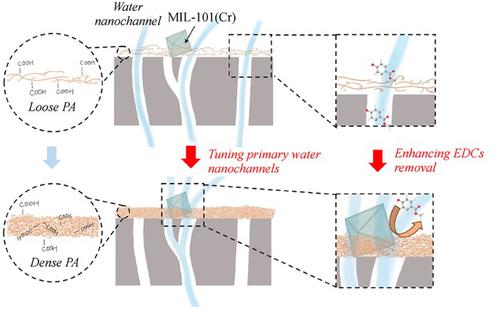Frontiers of Environmental Science & Engineering ( IF 6.4 ) Pub Date : 2021-07-09 , DOI: 10.1007/s11783-021-1474-7 Ruobin Dai 1 , Hongyi Han 1 , Zhiwei Wang 1 , Yuting Zhu 2 , Xi Wang 2

|
Metal organic framework (MOF) incorporated thin-film nanocomposite (TFN) membranes have the potential to enhance the removal of endocrine disrupting compounds (EDCs). In MOF-TFN membranes, water transport nanochannels include (i) pores of polyamide layer, (ii) pores in MOFs and (iii) channels around MOFs (polyamide-MOF interface). However, information on how to tune the nanochannels to enhance EDCs rejection is scarce, impeding the refinement of TFN membranes toward efficient removal of EDCs. In this study, by changing the polyamide properties, the water transport nanochannels could be confined primarily in pores of MOFs when the polyamide layer became dense. Interestingly, the improved rejection of EDCs was dependent on the water transport channels of the TFN membrane. At low monomer concentration (i.e., loose polyamide structure), the hydrophilic nanochannels of MIL-101(Cr) in the polyamide layer could not dominate the membrane separation performance, and hence the extent of improvement in EDCs rejection was relatively low. In contrast, at high monomer concentration (i.e., dense polyamide structure), the hydrophilic nanochannels of MIL-101(Cr) were responsible for the selective removal of hydrophobic EDCs, demonstrating that the manipulation of water transport nanochannels in the TFN membrane could successfully overcome the permeability and EDCs rejection trade-off. Our results highlight the potential of tuning primary selective nanochannels of MOF-TFN membranes for the efficient removal of EDCs.
中文翻译:

调节 MOF 薄膜纳米复合纳滤膜的主要选择性纳米通道以有效去除疏水性内分泌干扰化合物
金属有机框架 (MOF) 结合的薄膜纳米复合材料 (TFN) 膜具有增强内分泌干扰化合物 (EDC) 去除的潜力。在 MOF-TFN 膜中,水传输纳米通道包括 (i) 聚酰胺层的孔,(ii) MOF 中的孔和 (iii) MOF 周围的通道(聚酰胺-MOF 界面)。然而,关于如何调整纳米通道以增强 EDCs 排斥的信息很少,阻碍了 TFN 膜的改进以有效去除 EDCs。在这项研究中,通过改变聚酰胺的特性,当聚酰胺层变得致密时,水传输纳米通道可以主要限制在 MOF 的孔中。有趣的是,改善的 EDC 排斥取决于 TFN 膜的水传输通道。在低单体浓度(即松散的聚酰胺结构)下,聚酰胺层中 MIL-101(Cr) 的亲水性纳米通道不能主导膜分离性能,因此 EDCs 截留的改善程度相对较低。相比之下,在高单体浓度(即致密的聚酰胺结构)下,MIL-101(Cr) 的亲水性纳米通道负责选择性去除疏水性 EDC,表明 TFN 膜中水传输纳米通道的操作可以成功克服渗透性和 EDCs 拒绝权衡。我们的结果突出了调整 MOF-TFN 膜的初级选择性纳米通道以有效去除 EDC 的潜力。相比之下,在高单体浓度(即致密的聚酰胺结构)下,MIL-101(Cr) 的亲水性纳米通道负责选择性去除疏水性 EDC,表明 TFN 膜中水传输纳米通道的操作可以成功克服渗透性和 EDCs 拒绝权衡。我们的结果突出了调整 MOF-TFN 膜的初级选择性纳米通道以有效去除 EDC 的潜力。相比之下,在高单体浓度(即致密的聚酰胺结构)下,MIL-101(Cr) 的亲水性纳米通道负责选择性去除疏水性 EDC,表明 TFN 膜中水传输纳米通道的操作可以成功克服渗透性和 EDCs 拒绝权衡。我们的结果突出了调整 MOF-TFN 膜的初级选择性纳米通道以有效去除 EDC 的潜力。



























 京公网安备 11010802027423号
京公网安备 11010802027423号